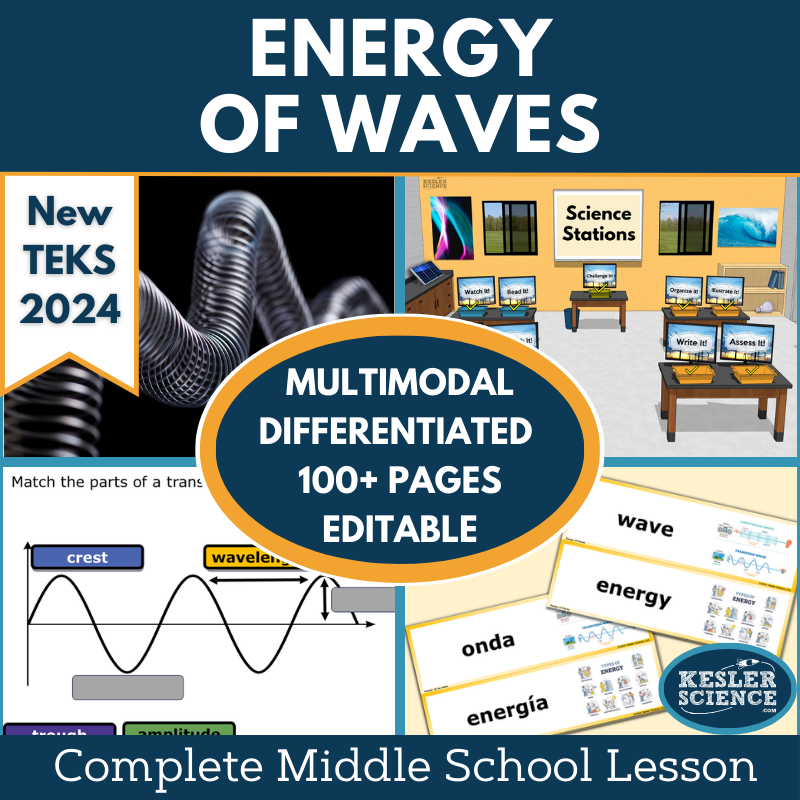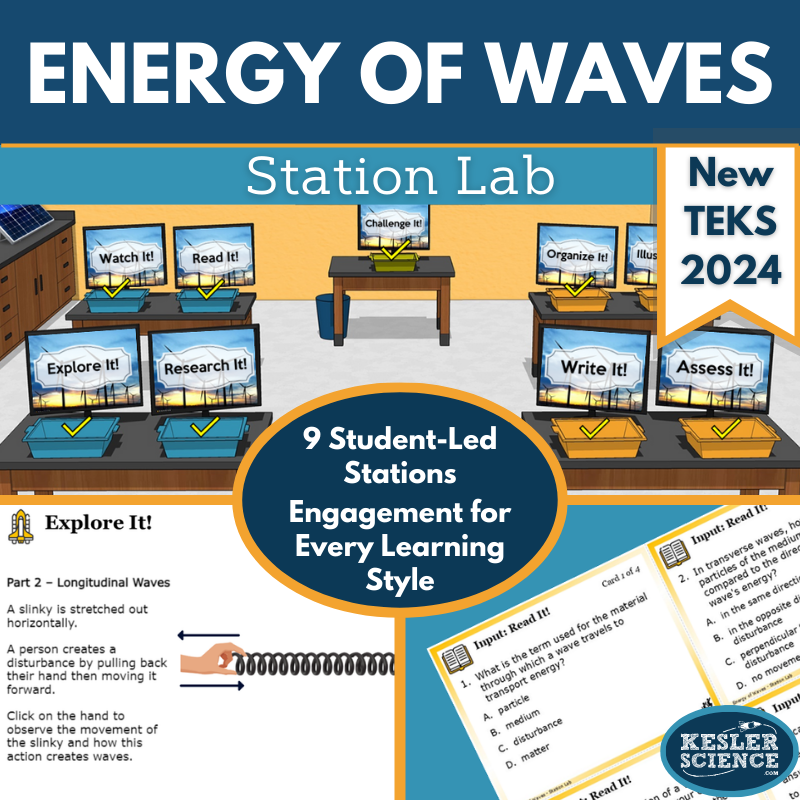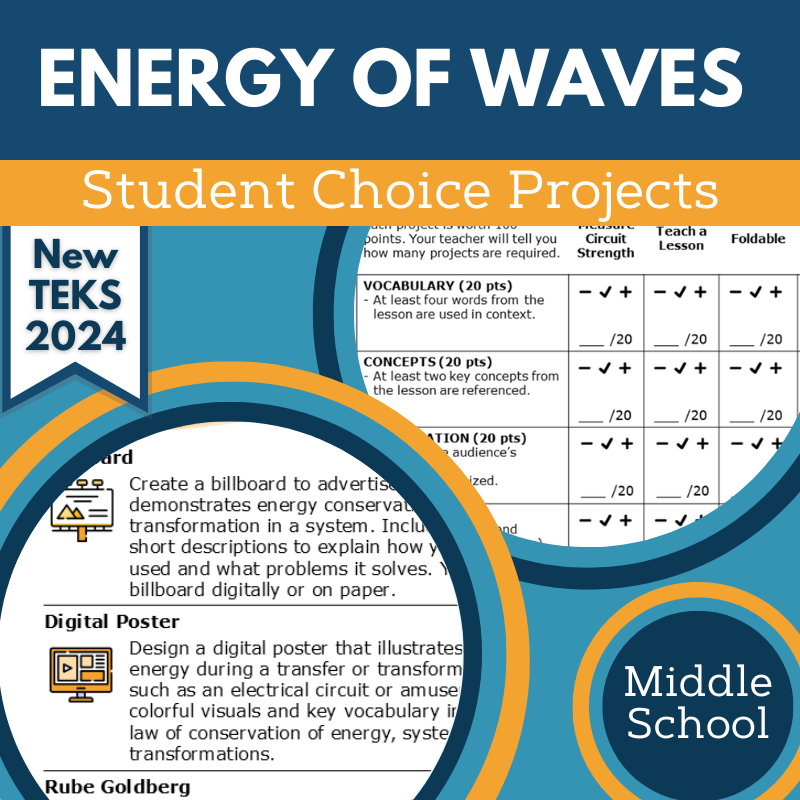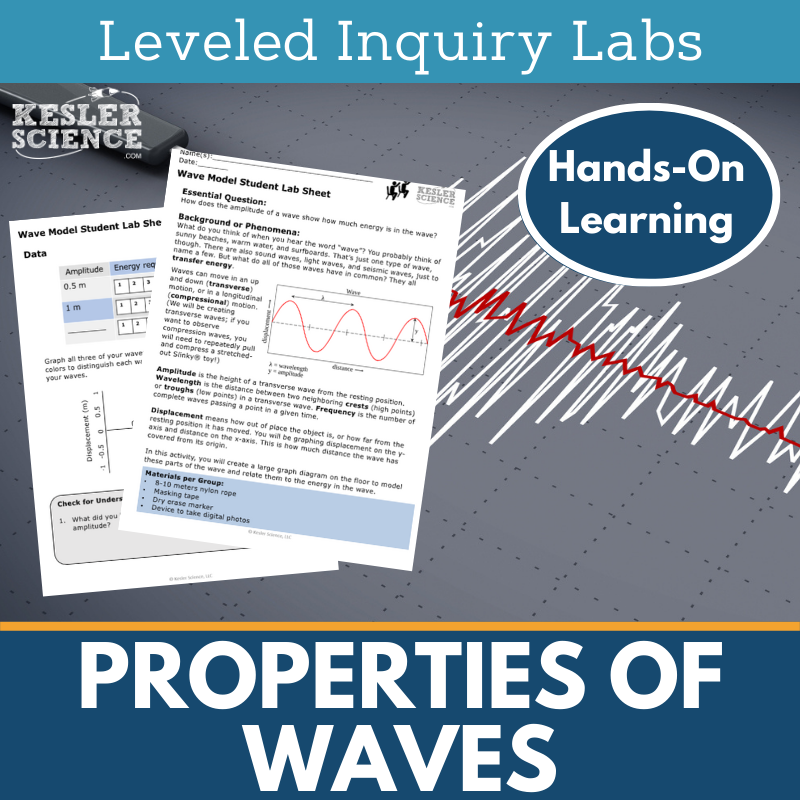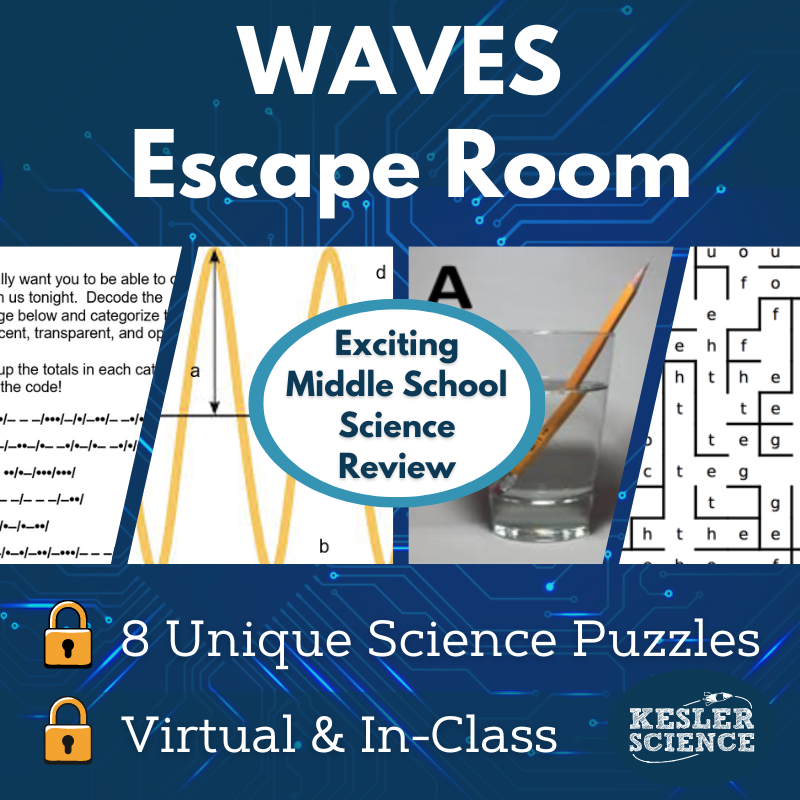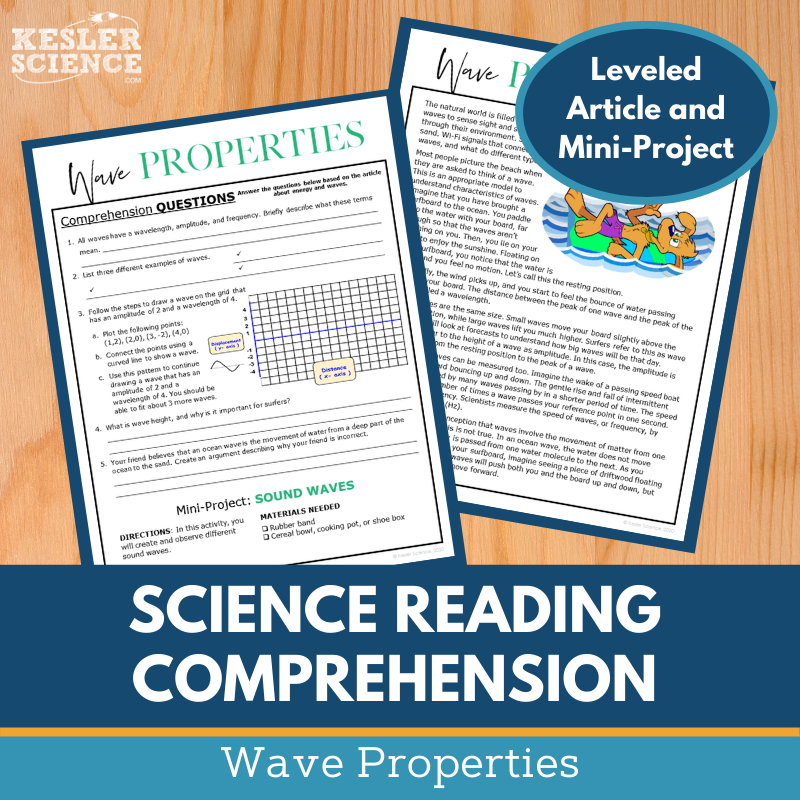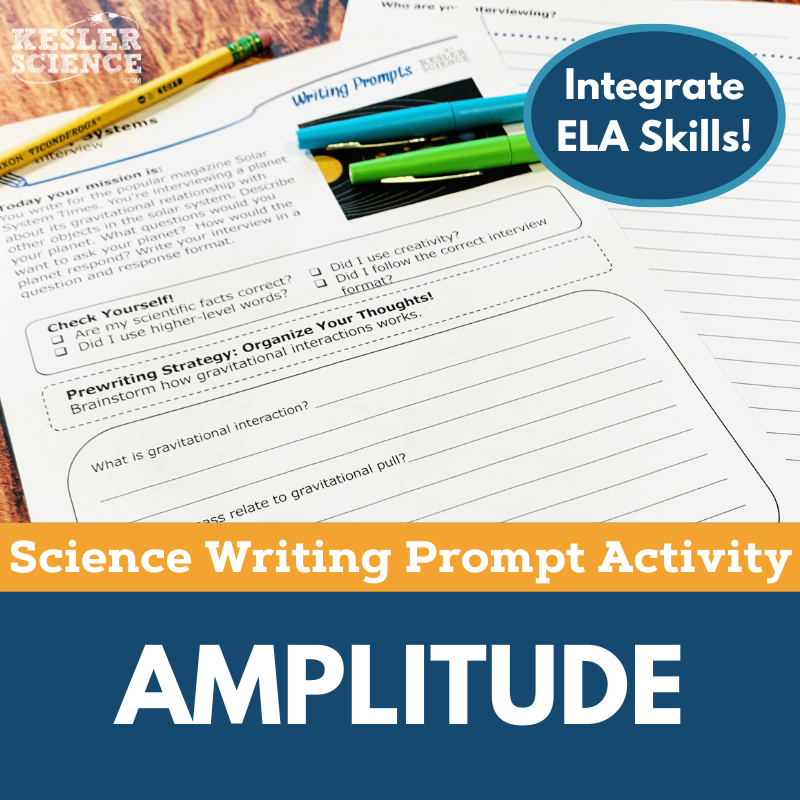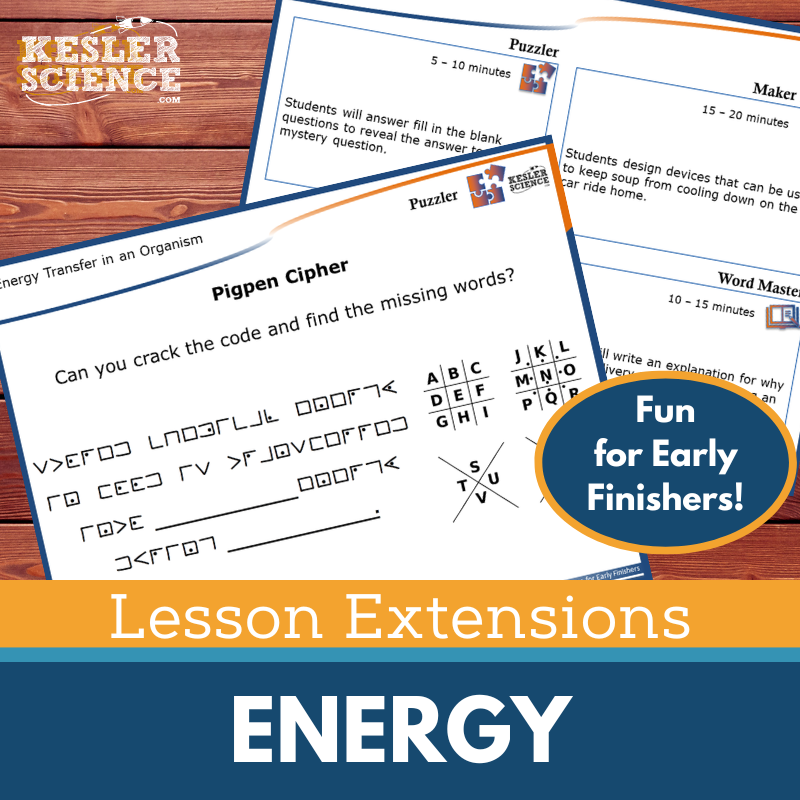Energy of Waves Activities for Middle School Science
Students explore how energy transfers through transverse and longitudinal waves in this engaging 5E lesson aligned with TEKS 6.8C. The resources below will give students a comprehensive understanding of wave energy. All of the following materials are also included in the Kesler Science Membership.
The Kesler Science Energy of Waves 5E Lesson is a comprehensive, student-led unit on how energy transfers through transverse and longitudinal waves, covering frequency, wavelength, and amplitude. It includes editable presentations, worksheets, assessments, and student-choice projects, designed for flexible, low-prep instruction. Aligned with the 2021 TEKS 6.8C standard, the lesson supports multimodal learning with Spanish translations for key materials.
The unit follows the 5E Model with structured activities for each phase. Engagement includes discussion prompts and vocabulary support. Exploration features a hands-on, differentiated station lab with nine stations, incorporating experiments, reading passages, videos, and interactive activities. Explanation provides editable PowerPoints, interactive notebooks, and note-taking templates. Elaboration offers student-choice projects, and Evaluation includes STAAR 2.0-aligned assessments and review materials.
This lesson is adaptable for in-class and virtual learning, ensuring all students engage with content in meaningful ways.
The Kesler Science Energy of Waves 5E Lesson is a comprehensive, student-led unit on how energy transfers through transverse and longitudinal waves, covering frequency, wavelength, and amplitude. It includes editable presentations, worksheets, assessments, and student-choice projects, designed for flexible, low-prep instruction. Aligned with the 2021 TEKS 6.8C standard, the lesson supports multimodal learning with Spanish translations for key materials.
The unit follows the 5E Model with structured activities for each phase. Engagement includes discussion prompts and vocabulary support. Exploration features a hands-on, differentiated station lab with nine stations, incorporating experiments, reading passages, videos, and interactive activities. Explanation provides editable PowerPoints, interactive notebooks, and note-taking templates. Elaboration offers student-choice projects, and Evaluation includes STAAR 2.0-aligned assessments and review materials.
This lesson is adaptable for in-class and virtual learning, ensuring all students engage with content in meaningful ways.
Engage your students with this modular, student-led station lab aligned with TEKS 6.8C, exploring how energy is transferred through transverse and longitudinal waves. Designed for in-class or virtual learning, this interactive lesson promotes student-driven exploration with nine differentiated stations.
Students engage with multimodal input stations, including hands-on activities, videos, readings, and research tasks. Output stations allow them to demonstrate learning through organizing information, illustrating models, writing responses, and completing assessments. A bonus challenge station offers extension activities for early finishers. With all necessary resources included, this low-prep, high-engagement lab fosters critical thinking and active participation.
Engage your students with this modular, student-led station lab aligned with TEKS 6.8C, exploring how energy is transferred through transverse and longitudinal waves. Designed for in-class or virtual learning, this interactive lesson promotes student-driven exploration with nine differentiated stations.
Students engage with multimodal input stations, including hands-on activities, videos, readings, and research tasks. Output stations allow them to demonstrate learning through organizing information, illustrating models, writing responses, and completing assessments. A bonus challenge station offers extension activities for early finishers. With all necessary resources included, this low-prep, high-engagement lab fosters critical thinking and active participation.
The Energy of Waves Student Choice Projects align with the 2021 TEKS standard 6.8C, allowing middle school students to select a project that fits their preferred output style. A project page outlines six student-led options plus a “design your own” project, all supported by an editable rubric for teacher, peer, or self-assessment. This resource is also included in the Energy of Waves Complete Lesson for TEKS 6.8C.
These flexible, multimodal projects provide creative ways for students to demonstrate their understanding. Two versions of the project page support differentiation, with modified options for students needing remediation and challenge opportunities for advanced learners. Teachers can adjust the rubric to fit grading needs.
The projects use standard classroom supplies like paper, markers, and scissors, with many options available for digital completion.
The Energy of Waves Student Choice Projects align with the 2021 TEKS standard 6.8C, allowing middle school students to select a project that fits their preferred output style. A project page outlines six student-led options plus a “design your own” project, all supported by an editable rubric for teacher, peer, or self-assessment. This resource is also included in the Energy of Waves Complete Lesson for TEKS 6.8C.
These flexible, multimodal projects provide creative ways for students to demonstrate their understanding. Two versions of the project page support differentiation, with modified options for students needing remediation and challenge opportunities for advanced learners. Teachers can adjust the rubric to fit grading needs.
The projects use standard classroom supplies like paper, markers, and scissors, with many options available for digital completion.
Students will construct a simple model of a transverse wave, aligning with NGSS MS PS4-1. This lab includes three differentiated versions to support different learning levels: a dependent student lab with structured instructions and inquiry questions, a modified student lab offering more support with sentence stems or multiple choice questions, and an independent student lab where students take the lead with minimal guidance.
The lab comes with teacher resource pages, answer keys, and CER (Claim, Evidence, Reasoning) conclusion questions for reflection. All materials are editable for easy customization. Materials needed per group include 8-10 meters of nylon rope, masking tape, a dry erase marker, and a device for digital photos.
This inquiry lab helps students use mathematical representations to describe wave models and understand how amplitude is related to energy.
Students will construct a simple model of a transverse wave, aligning with NGSS MS PS4-1. This lab includes three differentiated versions to support different learning levels: a dependent student lab with structured instructions and inquiry questions, a modified student lab offering more support with sentence stems or multiple choice questions, and an independent student lab where students take the lead with minimal guidance.
The lab comes with teacher resource pages, answer keys, and CER (Claim, Evidence, Reasoning) conclusion questions for reflection. All materials are editable for easy customization. Materials needed per group include 8-10 meters of nylon rope, masking tape, a dry erase marker, and a device for digital photos.
This inquiry lab helps students use mathematical representations to describe wave models and understand how amplitude is related to energy.
The Properties of Waves Escape Room is an interactive, student-centered activity that allows students to demonstrate their knowledge of light and sound waves in a fun and engaging way. Students need to understand wave properties and be familiar with terms like transparent, translucent, opaque, transverse, longitudinal, light waves, and sound waves.
Unlike traditional escape rooms, teachers have full control over the 8 independent puzzles, choosing which to use and in what order. This flexibility makes it easy to adapt the activity for different class periods.
The escape room can be run with basic materials like manila envelopes, or you can opt for a more immersive experience with locks and a storage box. All printed materials are included, and there are two options for online use: a digital version via PowerPoint or Google Slides, and a printable version for home use.
Included in the product are teacher directions, detailed answer keys, a digital answer sheet for Google Classroom, a video challenge to set the mood, eight unique puzzles with printable props, over 50 prize ideas, reward templates, and customizable photo signs.
This immersive experience will have students excited to talk about the lesson long after it’s over.
The Properties of Waves Escape Room is an interactive, student-centered activity that allows students to demonstrate their knowledge of light and sound waves in a fun and engaging way. Students need to understand wave properties and be familiar with terms like transparent, translucent, opaque, transverse, longitudinal, light waves, and sound waves.
Unlike traditional escape rooms, teachers have full control over the 8 independent puzzles, choosing which to use and in what order. This flexibility makes it easy to adapt the activity for different class periods.
The escape room can be run with basic materials like manila envelopes, or you can opt for a more immersive experience with locks and a storage box. All printed materials are included, and there are two options for online use: a digital version via PowerPoint or Google Slides, and a printable version for home use.
Included in the product are teacher directions, detailed answer keys, a digital answer sheet for Google Classroom, a video challenge to set the mood, eight unique puzzles with printable props, over 50 prize ideas, reward templates, and customizable photo signs.
This immersive experience will have students excited to talk about the lesson long after it’s over.
This lesson helps middle school students explore how the amplitude of a wave relates to its energy. Students read a nonfiction article about wave properties, and afterwards, they complete comprehension questions and engage in a hands-on mini-project to create and observe sound waves.
The leveled passage, suitable for grades 6-8 (and advanced 5th graders), includes 5-7 comprehension questions and a mini-project. It also provides a Cornell notes template and colorful, printable graphics. The resource is ideal for in-person or virtual learning environments, with files that are compatible with platforms like Google Classroom, MS Teams, Schoology, and Canvas.
Perfect for absent students, extra credit, or whole-class instruction, this passage supports science literacy, reading comprehension, and classroom discussions. Teachers can use it throughout a unit to build understanding of wave properties and to foster critical thinking and textual analysis skills.
This lesson helps middle school students explore how the amplitude of a wave relates to its energy. Students read a nonfiction article about wave properties, and afterwards, they complete comprehension questions and engage in a hands-on mini-project to create and observe sound waves.
The leveled passage, suitable for grades 6-8 (and advanced 5th graders), includes 5-7 comprehension questions and a mini-project. It also provides a Cornell notes template and colorful, printable graphics. The resource is ideal for in-person or virtual learning environments, with files that are compatible with platforms like Google Classroom, MS Teams, Schoology, and Canvas.
Perfect for absent students, extra credit, or whole-class instruction, this passage supports science literacy, reading comprehension, and classroom discussions. Teachers can use it throughout a unit to build understanding of wave properties and to foster critical thinking and textual analysis skills.
The Amplitude Science Writing Prompt Activity helps middle school students test their knowledge of physical science through a song-based exercise. Aligned with the NGSS MS PS4-1 standard, it explores how amplitude relates to wave energy. This engaging, low-prep activity supports virtual learning, making it perfect for both in-class and remote students.
Included are teacher directions with answer guides, project ideas, and rubrics; a projection version for classroom or virtual sharing; full-sized and half-sheet handouts with the writing prompt, self-check, and pre-writing strategies; and a digital interactive version for Google Slides or PowerPoint, ideal for in-person or remote learners.
The activity can be used for cross-curricular projects, pre-test assessments, student choice assignments, differentiation, and more. It's also great for bulletin boards or creating student anthologies. The prompts assume prior knowledge of the topic or access to research materials.
The Amplitude Science Writing Prompt Activity helps middle school students test their knowledge of physical science through a song-based exercise. Aligned with the NGSS MS PS4-1 standard, it explores how amplitude relates to wave energy. This engaging, low-prep activity supports virtual learning, making it perfect for both in-class and remote students.
Included are teacher directions with answer guides, project ideas, and rubrics; a projection version for classroom or virtual sharing; full-sized and half-sheet handouts with the writing prompt, self-check, and pre-writing strategies; and a digital interactive version for Google Slides or PowerPoint, ideal for in-person or remote learners.
The activity can be used for cross-curricular projects, pre-test assessments, student choice assignments, differentiation, and more. It's also great for bulletin boards or creating student anthologies. The prompts assume prior knowledge of the topic or access to research materials.
The WIKI Tickets© Energy Set provides 18 formative assessments for 6th-8th grade science, offering flexible ways to check student understanding. Each topic includes five format options: a full-screen projection version, three printable handouts (full, split, and quarter-page sizes), and an interactive digital version available as an editable PowerPoint or Google Slides file.
Aligned with NGSS and TEKS standards, these assessments cover key energy-related topics such as energy transformations, heat transfer, kinetic and potential energy, wave characteristics, and photosynthesis. Some topics include multiple tickets, ensuring comprehensive coverage, and a table of contents file is included for easy alignment reference.
Designed for both in-person and virtual learning, WIKI Tickets© can be used as exit tickets, bellringers, or quick checks. Students can write responses on their own paper when projected or complete digital versions in a 1:1 or remote setting. These engaging assessments help you gauge student progress with ease.
The WIKI Tickets© Energy Set provides 18 formative assessments for 6th-8th grade science, offering flexible ways to check student understanding. Each topic includes five format options: a full-screen projection version, three printable handouts (full, split, and quarter-page sizes), and an interactive digital version available as an editable PowerPoint or Google Slides file.
Aligned with NGSS and TEKS standards, these assessments cover key energy-related topics such as energy transformations, heat transfer, kinetic and potential energy, wave characteristics, and photosynthesis. Some topics include multiple tickets, ensuring comprehensive coverage, and a table of contents file is included for easy alignment reference.
Designed for both in-person and virtual learning, WIKI Tickets© can be used as exit tickets, bellringers, or quick checks. Students can write responses on their own paper when projected or complete digital versions in a 1:1 or remote setting. These engaging assessments help you gauge student progress with ease.
Lesson Extensions provide engaging, student-choice activities designed to challenge early finishers and deepen their understanding of energy concepts. These activities help reinforce critical thinking, creativity, and problem-solving, while keeping students engaged in rigorous yet enjoyable learning opportunities. They are ideal for lesson wrap-ups, enrichment, or filling downtime during testing.
Each extension includes four interactive components: Puzzler for problem-solving, Maker Space for hands-on STEAM activities, Tech Connection for digital media demonstrations, and Word Master for creative writing. Teacher directions, answer keys, and both print and projection versions ensure easy implementation.
Aligned to NGSS and TEKS energy standards, these extensions cover topics such as energy transformations, kinetic and potential energy, thermal energy transfer, the electromagnetic spectrum, and photosynthesis. They provide high-level, independent learning opportunities to help students explore energy concepts in greater depth.
Lesson Extensions provide engaging, student-choice activities designed to challenge early finishers and deepen their understanding of energy concepts. These activities help reinforce critical thinking, creativity, and problem-solving, while keeping students engaged in rigorous yet enjoyable learning opportunities. They are ideal for lesson wrap-ups, enrichment, or filling downtime during testing.
Each extension includes four interactive components: Puzzler for problem-solving, Maker Space for hands-on STEAM activities, Tech Connection for digital media demonstrations, and Word Master for creative writing. Teacher directions, answer keys, and both print and projection versions ensure easy implementation.
Aligned to NGSS and TEKS energy standards, these extensions cover topics such as energy transformations, kinetic and potential energy, thermal energy transfer, the electromagnetic spectrum, and photosynthesis. They provide high-level, independent learning opportunities to help students explore energy concepts in greater depth.
This Amazing Anchors phenomenon lesson introduces the energy of waves through a two-part resource. It includes an introductory reading about a surfer in Brazil, followed by comprehension and extension questions to prepare students for further learning. The second part provides an explanatory reading that breaks down the science behind the energy of waves, with additional questions to reinforce student understanding.
The lesson includes teacher directions, answer keys, and additional resources. It is available in a projection version with full-page slides, a digital version for LMS platforms, and a paper version for handouts.
Aligned with NGSS standard MS PS4-1, this lesson can be used in both print and digital formats, making it ideal for both in-person and distance learning. The lesson is differentiated with a dependent version and a modified version that offers sentence starters for student support.
Designed to supplement your own lessons, the readings and questions provide an engaging way to explore the energy of waves.
This Amazing Anchors phenomenon lesson introduces the energy of waves through a two-part resource. It includes an introductory reading about a surfer in Brazil, followed by comprehension and extension questions to prepare students for further learning. The second part provides an explanatory reading that breaks down the science behind the energy of waves, with additional questions to reinforce student understanding.
The lesson includes teacher directions, answer keys, and additional resources. It is available in a projection version with full-page slides, a digital version for LMS platforms, and a paper version for handouts.
Aligned with NGSS standard MS PS4-1, this lesson can be used in both print and digital formats, making it ideal for both in-person and distance learning. The lesson is differentiated with a dependent version and a modified version that offers sentence starters for student support.
Designed to supplement your own lessons, the readings and questions provide an engaging way to explore the energy of waves.
Year-Round Resources
These year-round activities will increase your students' understanding of many middle school science topics. All of these activities are also included in the Kesler Science Membership.
Visual Data & Graphing
You're not alone if your students struggle with understanding graphs, charts, and tables. It's a skill that takes an enormous amount of practice. This resource will help students build a strong foundation in analyzing data and creating their own data visualizations.
Bell Ringers and Warm-Ups
These middle school science bell ringers are an excellent way to engage your students as soon as they walk into your classroom. This comprehensive FULL YEAR resource includes everything you need to start off each science class with an interesting warm-up activity.
Review Board Games
Each game board has been carefully designed to keep students engaged. There are 10 different action spaces on each board and dozens of question cards. All of the actions are related to science concepts and keep the students motivated throughout the game.
Each game is ready to play. Simply print out the board and the cards and let the students enjoy reviewing nine different units.
Essential Questions and Standards
Below are the essential questions and standards associated with the lessons and activities included in the atoms unit. This topic is only one of more than 100 middle school science topics included in the Kesler Science Membership.
-
How is energy transferred through transverse and longitudinal waves?
-
TEKS Science - 6.8C Energy of Waves
Kesler Science Membership
Imagine never having to search for another middle school science lesson again. The membership gives you access to ALL of the Kesler Science products in one place (Yes, including everything above).
Say goodbye to long hours of lesson prep.

